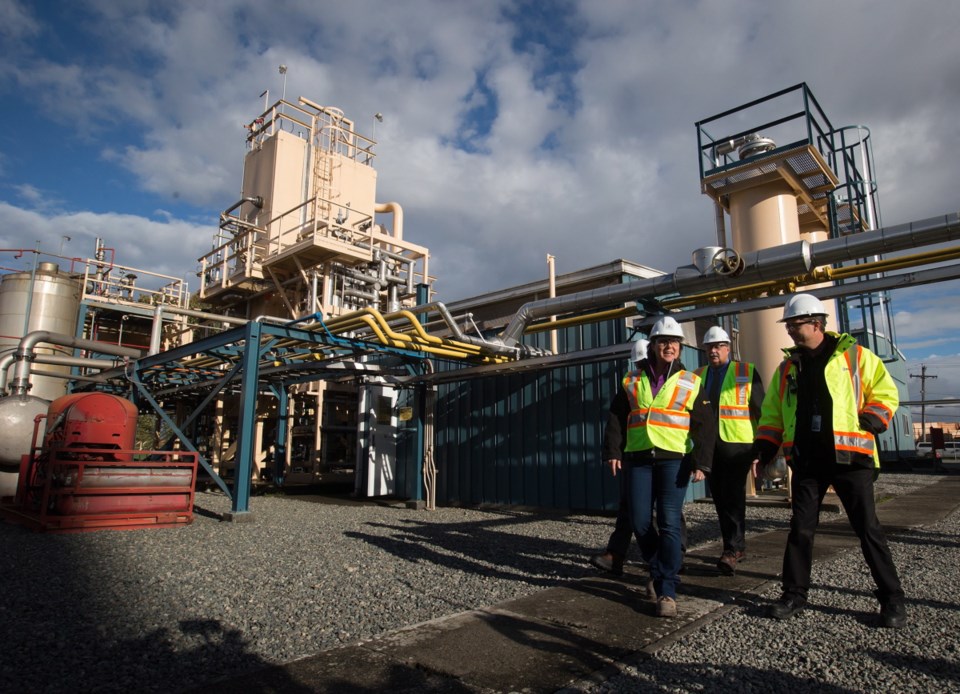 Despite a dramatic drop in the projected revenues from liquefied natural gas, Finance Minister Mike de Jong said Tuesday there’s still a strong case to pursue the opportunity.
Despite a dramatic drop in the projected revenues from liquefied natural gas, Finance Minister Mike de Jong said Tuesday there’s still a strong case to pursue the opportunity.
The new modelling that backed up the Liquefied Natural Gas Income Tax Act shows a significant downgrade in the delirium-inducing revenue estimates that seized the B.C. Liberals’ imagination two years ago. LNG was pitched — pre-election — as being the motherlode for a staggering new source of wealth, from which the province was going to extract almost unimaginable sums of money.
Things got a bit more realistic on Tuesday. The price of gas is dropping, partly because of a global supply glut and partly because other countries are moving faster in Asia. There’s also a realization that construction costs for the proposed multibillion-dollar projects will be higher than expected, because of competition for resources.
It’s still an attractive proposition, but it’s over a long period of time and it apparently needs careful coddling by government. So the Liberals went out of their way to make the new income tax on the proposed industry as bearable as possible. The similar gentle touch was on display Monday, when emission standards were set with lots of flexibility and subsidies for plants that need help meeting the targets.
The income-tax framework laid last February contemplated a rate of up to seven per cent. If the early bonanza price gap had held strong, maybe it would have been near that. But when the magic number was revealed, it was 3.5 per cent, half the projected maximum. That’s a 50 per cent cut from what was envisioned, in just eight months. The rate is locked in from 2017 to 2037, before it rises to five per cent.
As with the February version, the initial rate will actually be 1.5 per cent for the first few years while companies sustain operating losses and deduct building costs.
As well, the government offered to shave three points off another portion of the LNG industry’s tax load, the corporate income tax. The bill cuts the rate to eight per cent from 11, if proponents set up as B.C. companies. The income tax climb-down has a stark effect on the revenue projections. De Jong produced graphics showing 10 years of revenue from one hypothetical mid-sized plant under the February version of the tax. It totalled about $1.5 billion. Then he showed the revised version using Tuesday’s rate. It’s about $800 million.
There was a lot of talk over the past year about how tough negotiations were and how B.C. needed a fair share for the resource. De Jong said the new tax rate reflects fairness. But there was a lot more emphasis Tuesday on a rate that “is more attractive to investors and more indicative of current market conditions.”
Even with reduced expectations, the numbers are still huge. The total tax take from just one mid-sized LNG plant would equal the government’s annual take from the entire forest industry. And the target is to have five by 2020.
When royalties, the carbon tax and all other taxes are included with the new LNG income tax — along with a number of assumptions — the government is still projecting big ongoing revenues from the industry.
But de Jong was noticeably shy about recounting all the plans for the “Prosperity Fund.” Premier Christy Clark announced its creation in February 2013.
“Billions of dollars will be dedicated … to eliminate the provincial debt over time,” said her announcement. “More than $100 billion will flow into the Prosperity Fund.”
De Jong said the new estimates show LNG is “not quite as lucrative as it once was. The market has changed.”
But he pronounced himself satisfied that there is still a strong case for the investment.
The entire vision, which has spurred $2 billion worth of site development work, is based on the belief natural gas can be shipped as LNG to Asia and garner a higher price than in North America.
The 18 proponents now in play will spend the next several weeks or months seeing if B.C.’s numbers work, and determining if that assumption will hold.



